- Home
- About
- Map
- Trips
- Bringing Boat West
- Migration West
- Solo Motorcycle Ride
- Final Family XC Trip
- Colorado Rockies
- Graduates' XC Trip
- Yosemite & Nevada
- Colorado & Utah
- Best of Utah
- Southern Loop
- Pacific Northwest
- Northern Loop
- Los Angeles to NYC
- East Coast Trips
- 1 Week in Quebec
- Southeast Coast
- NH Backpacking
- Martha's Vineyard
- Canadian Maritimes
- Ocracoke Island
- Edisto Island
- First Landing '02
- Hunting Island '02
- Stowe in Winter
- Hunting Island '01
- Lake Placid
- Chesapeake
- Provincetown
- Hunting Island '00
- Acadia in Winter
- Boston Suburbs
- Niagara Falls
- First Landing '99
- Cape Hatteras
- West Coast Trips
- Maui
- Mojave 4WD Course
- Colorado River Rafting
- Bishop & Death Valley
- Kauai
- Yosemite Fall
- Utah Off-Road
- Lost Coast
- Yosemite Valley
- Arizona and New Mexico
- Pescadero & Capitola
- Bishop & Death Valley
- San Diego, Anza Borrego, Joshua Tree
- Carmel
- Death Valley in Fall
- Yosemite in the Fall
- Pacific Northwest
- Utah Off-Roading
- Southern CA Deserts
- Yosemite & Covid
- Lake Powell Covid
- Eastern Sierra & Covid
- Bishop & Death Valley
- Central & SE Oregon
- Mojave Road
- Eastern Sierra
- Trinity Alps
- Tuolumne Meadows
- Lake Powell Boating
- Eastern Sierra
- Yosemite Winter
- Hawaii
- 4WD Eastern Sierra
- 4WD Death Valley +
- Southern CA Deserts
- Christmas in Tahoe
- Yosemite & Pinnacles
- Totality
- Yosemite & Sierra
- Yosemite Christmas
- Yosemite, San Diego
- Yosemite & North CA
- Seattle to Sierra
- Southwest Deserts
- Yosemite & Sierra
- Pacific Northwest
- Yosemite & South CA
- Pacific Northwest
- Northern California
- Southern Alaska
- Vancouver Island
- International Trips
- Index
- Tips
- Books
- Photos/Videos
- Search
- Contact
Death Valley National Park, CA
Wednesday, November 12, 2014 - 11:15am by Lolo
120 miles and 2.5 hours from our last stop - 3 night stay
Travelogue
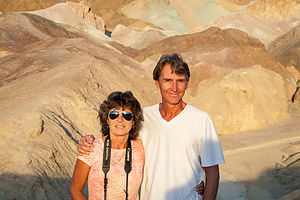 Lolo and Herb at Artist’s PaletteWhat a difference the season makes! When we were here in August of 2007, all I can remember is everyone moaning and groaning about the oppressive heat. But November is a totally different story, with clear sunny days in the mid to upper 70s, and nights falling to a comfortable 50 degrees. Spirits were significantly higher this time than the last.
Lolo and Herb at Artist’s PaletteWhat a difference the season makes! When we were here in August of 2007, all I can remember is everyone moaning and groaning about the oppressive heat. But November is a totally different story, with clear sunny days in the mid to upper 70s, and nights falling to a comfortable 50 degrees. Spirits were significantly higher this time than the last.
Despite its large size – Death Valley is the largest National Park outside of Alaska – you can still see quite a bit of it a 2 to 3 day visit. Many of its highlights are quite accessible via a short walk from the car. Other, more remote areas of the park are only accessible with off-road vehicles on some pretty, long bumpy roads.
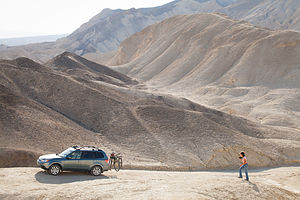 Subaru and Lolo on Twenty Mule Team Canyon RoadWe entered the park from the east on Route 190 and drove directly to the Furnace Creek Campground to ensure that we could get a site for a few nights. Although fairly busy, there fortunately were a few left, so we selected one with nice views, decoupled the Subaru, and then headed back out to explore.
Subaru and Lolo on Twenty Mule Team Canyon RoadWe entered the park from the east on Route 190 and drove directly to the Furnace Creek Campground to ensure that we could get a site for a few nights. Although fairly busy, there fortunately were a few left, so we selected one with nice views, decoupled the Subaru, and then headed back out to explore.
One thing we don’t like about traveling this time of year is how early it gets dark. By 5:00 you’re pretty much done for the day.
We really had time for only one event, so we chose to catch the evening light along the scenic Artists Drive, a 9-miled paved spur road that winds through a colorful display of sedimentary and volcanic rock. Fortunately, we had the Subaru, because RVs longer than 25 feet are not allowed. We stopped at a viewpoint called Artists Pallet, named for the amazing rainbow of colors – red, pink, yellow, orange and brown – that paint the hills.
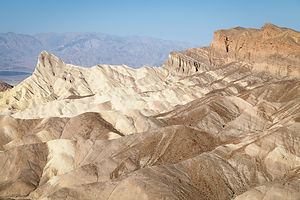 Zabriskie PointThere was a lot of ground to cover over the next 2 days, so we went to bed early and got an early start the next morning to catch the sunrise at Dante’s View, an overlook 5,000 feet above the valley floor, which many consider the best place to watch sunrise in the park. We didn’t quite make it for sunrise, but we were there pretty early. Unfortunately, there was a haze that hung over the valley, obscuring what I am sure would have been a very spectacular view.
Zabriskie PointThere was a lot of ground to cover over the next 2 days, so we went to bed early and got an early start the next morning to catch the sunrise at Dante’s View, an overlook 5,000 feet above the valley floor, which many consider the best place to watch sunrise in the park. We didn’t quite make it for sunrise, but we were there pretty early. Unfortunately, there was a haze that hung over the valley, obscuring what I am sure would have been a very spectacular view.
We headed back up 190, and turned off onto the one-way dirt Twenty-Mule Team Canyon Road, named for the teams of mules that used to pull wagons loaded with borax mined in these canyons along this road during the 1880s. Borax was big business in Death Valley at that time. Have I mentioned how much we like having a 4-wheel drive tow vehicle? There are so many places in this park that you can’t get to in an RV, or even in a regular car. This road, which wound 2.7 miles through colorful badlands, was awesome, and during our entire time on it, including many stops, we never saw another soul. We just pulled over to the side of the road whenever we wanted to take pictures, which I would have to say was quite often. We probably spent over an hour covering the 3 miles.
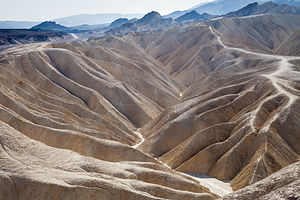 Zabriskie Point OverlookBack on 190, we stopped at Zabriskie Point, another spectacular viewpoint that claims to be the park’s best. From the overlook, the panoramic view of Golden Canyon and the surrounding colorful badlands was truly breathtaking. There was a photographer taking pictures of a solitary girl in a wedding gown – I hesitate to say bride, because there was no groom and I did catch a glimpse of jeans under her gown. What a backdrop for a wedding photo!!
Zabriskie Point OverlookBack on 190, we stopped at Zabriskie Point, another spectacular viewpoint that claims to be the park’s best. From the overlook, the panoramic view of Golden Canyon and the surrounding colorful badlands was truly breathtaking. There was a photographer taking pictures of a solitary girl in a wedding gown – I hesitate to say bride, because there was no groom and I did catch a glimpse of jeans under her gown. What a backdrop for a wedding photo!!
After a quick lunch back at Furnace Creek, we spent the afternoon exploring stops along the road to Badwater Basin. Our first stop was the Devil’s Golf Course, an interesting expanse of jagged rock salt spires, shaped by the erosion of wind and rain – a landscape so harsh and otherworldly that only a devil would think of playing golf on it.
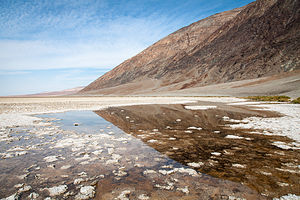 BadwaterWe continued on to Badwater Basin, which at 282 feet below sea level is the lowest, driest, hottest place in North America. After the obligatory pose by the Badwater sign, we headed out across the boardwalk, past a small salt lagoon, and onto the salt flats themselves, a surreal, otherworldly highway made of table salt. You can go on for miles if you choose, all the way to the other side of the Valley, but we chose to go for just about a mile before turning back.
BadwaterWe continued on to Badwater Basin, which at 282 feet below sea level is the lowest, driest, hottest place in North America. After the obligatory pose by the Badwater sign, we headed out across the boardwalk, past a small salt lagoon, and onto the salt flats themselves, a surreal, otherworldly highway made of table salt. You can go on for miles if you choose, all the way to the other side of the Valley, but we chose to go for just about a mile before turning back.
On the way back north from Badwater Basin, we took a 1.5-mile bumpy dirt road to the trailhead for the hike to Natural Bridge, once again feeling grateful to have our Subaru along. From the parking lot, we immediately entered the mouth of a canyon and hiked uphill for about a ½ mile before arriving at our goal, a 50-foot high massive rock that spans the canyon.
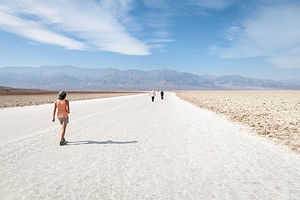 Lolo Hiking Badwater Basin Salt FlatWe were really efficiently knocking off lots of sites in the park. Time for a break. Wanting to flex the Subaru’s off-road capabilities a bit, Herb took the turnoff for the unpaved West Side Road which led further out into the valley, not with any particular destination in mind, but just because he could. Herb likes desolation a lot more than I do and loves getting to places where there isn’t another soul around for miles. Well, this was the place. Although the road goes on for about 40 miles, we pulled over in about 3, got the beach chairs out and just sat. It was so starkly beautiful and totally silent and still. Herb was right. It probably is good to do this once in a while. He just likes doing it longer than me.
Lolo Hiking Badwater Basin Salt FlatWe were really efficiently knocking off lots of sites in the park. Time for a break. Wanting to flex the Subaru’s off-road capabilities a bit, Herb took the turnoff for the unpaved West Side Road which led further out into the valley, not with any particular destination in mind, but just because he could. Herb likes desolation a lot more than I do and loves getting to places where there isn’t another soul around for miles. Well, this was the place. Although the road goes on for about 40 miles, we pulled over in about 3, got the beach chairs out and just sat. It was so starkly beautiful and totally silent and still. Herb was right. It probably is good to do this once in a while. He just likes doing it longer than me.
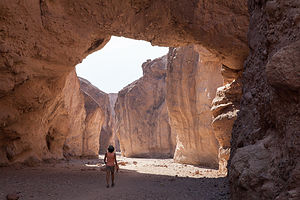 Lolo Hiking Natural BridgeOur last stop in this already full day was the hike through Golden Canyon, which I am convinced, is the absolute best hike in the park. I only wish we had allowed more time to complete the side trip up to Zabriskie Point, but we were only able to do part of it or we would have had to hike out in the dark – I hate these short days.
Lolo Hiking Natural BridgeOur last stop in this already full day was the hike through Golden Canyon, which I am convinced, is the absolute best hike in the park. I only wish we had allowed more time to complete the side trip up to Zabriskie Point, but we were only able to do part of it or we would have had to hike out in the dark – I hate these short days.
The first mile of the trail leads through a narrow colorful canyon. An interpretive pamphlet, which we picked up at the trailhead, explained the geological features of each of ten numbered markers in the first mile of the canyon. Rock is not just rock, and it’s much more fun to know a little bit about what you’re seeing.
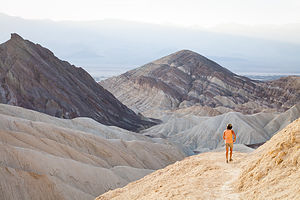 Lolo Hiking Golden CanyonSurprisingly, a paved road used to go through his canyon, but was washed away in a flash flood in 1976. In many places, we could still see chunks of asphalt poking through the ground.
Lolo Hiking Golden CanyonSurprisingly, a paved road used to go through his canyon, but was washed away in a flash flood in 1976. In many places, we could still see chunks of asphalt poking through the ground.
Although the interpretive section of the hike ended at the one mile mark near marker 10, we continued upwards where the canyon eventually opened up to a vista of multi-colored badlands.
We followed the sign towards Zabriskie Point, and almost immediately the trail began to climb more steeply. It was hard to notice though because we were so distracted by the views. At about the 1.6 mile point we passed under a sharp, fin-like formation called Manly Beacon.
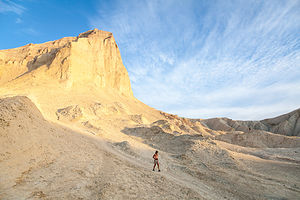 Golden Canyon with Hiking LoloAt 2 miles we came to a junction that was not clearly marked and had to make a decision. Continue steeply upward to Zabriskie Point, which we calculated as only another ½ mile, but then 2 ½ miles back down, hike down on what we thought was the alternative Gower Gulch trail, or turn around and head back the way we came. If it wasn’t so late in the afternoon, we definitely would have chosen to forge on ahead to Zabriskie Point, but because of the late hour and our uncertainly about the Gower Gulch trail, we retraced our steps – still not a bad decision as the view from a different direction and the changing light made it seem like new.
Golden Canyon with Hiking LoloAt 2 miles we came to a junction that was not clearly marked and had to make a decision. Continue steeply upward to Zabriskie Point, which we calculated as only another ½ mile, but then 2 ½ miles back down, hike down on what we thought was the alternative Gower Gulch trail, or turn around and head back the way we came. If it wasn’t so late in the afternoon, we definitely would have chosen to forge on ahead to Zabriskie Point, but because of the late hour and our uncertainly about the Gower Gulch trail, we retraced our steps – still not a bad decision as the view from a different direction and the changing light made it seem like new.
I would have to say that this hike is probably up there in my top 10 all-time favorites. Next time we are here, we will start early enough to do the whole Golden Canyon to Zabriskie Point to Gower Gulch route.
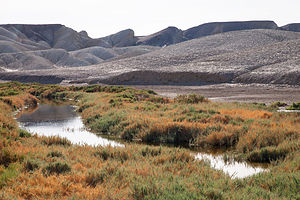 Salt Creek sans PupfishThe next day we decided to explore the northern portion of the park. We began our journey with an interesting man-made point of interest, the Harmony Borax Works. As much as I love natural beauty, I very much enjoy mixing in a little cultural history as well.
Salt Creek sans PupfishThe next day we decided to explore the northern portion of the park. We began our journey with an interesting man-made point of interest, the Harmony Borax Works. As much as I love natural beauty, I very much enjoy mixing in a little cultural history as well.
Death Valley would have had minimal human history if it wasn’t for the discovery of Borax near what is now the Furnace Creek Ranch. From 1883 through 1888, this was the site of a plant where 40 employees produced three tons of borax each day. From this site, Twenty Mule Teams would haul the borax over the long overland route to Mojave. Today, all that is left of the thriving Harmony Borax Works are some adobe ruins of the plant and an original twenty mule team wagon. We took the short, interpretive trail around the ruins, reading signs explaining its history along the way.
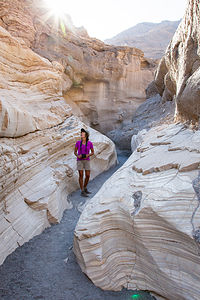 Lolo in Mosaic CanyonA little further north from the Borax Works is the Salt Creek Interpretive Trail, a rare chance to see water in Death Valley. It’s not exactly a hike, but more of a pleasant stroll on a mile-long boardwalk. The tiny little creek here is home to the inch-long Salt Creek Pupfish, a hearty little creature that somehow manages to survive these harsh conditions. Unfortunately, they are usually only visible in the spring, and as much as we tried, there were none to be seen. Still, it was a very pretty stroll, and I did learn to identify pickleweed, a cute little plant that thrives in salty conditions.
Lolo in Mosaic CanyonA little further north from the Borax Works is the Salt Creek Interpretive Trail, a rare chance to see water in Death Valley. It’s not exactly a hike, but more of a pleasant stroll on a mile-long boardwalk. The tiny little creek here is home to the inch-long Salt Creek Pupfish, a hearty little creature that somehow manages to survive these harsh conditions. Unfortunately, they are usually only visible in the spring, and as much as we tried, there were none to be seen. Still, it was a very pretty stroll, and I did learn to identify pickleweed, a cute little plant that thrives in salty conditions.
We made a short diversion off of 190 through the town, and I use the word “town” loosely, of Stovepipe Wells to get to the trailhead for Mosaic Canyon. It’s amazing how different each canyon in the park is. This one is the drainage for the Tucki Mountain, so it is subject to periodic flash floods that have scoured the rock into a smooth, polished marble, so smooth in places that it is slippery to walk on. Although the canyon continues on for about 2 miles, we stopped at the half mile point, as do most hikers, where the canyon opens up to expansive gravel wash. This marked the top of the lower canyon and the end of the interpretive part of the trail.
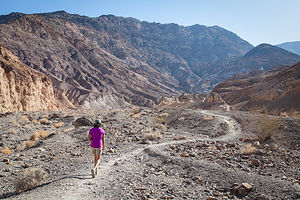 Lolo Hiking Mosaic CanyonBack at the junction for 190, we debated as to whether we should drive the 40 miles all the way up to Scotty’s Castle, since we had already been on a tour of it in 2007. However, we hadn’t been to Ubehebe Crater, which was nearby, so we decided to take the drive. Besides, it really is a very beautiful stretch of road, with desert views to the west and alluvial fans and mountains to the east.
Lolo Hiking Mosaic CanyonBack at the junction for 190, we debated as to whether we should drive the 40 miles all the way up to Scotty’s Castle, since we had already been on a tour of it in 2007. However, we hadn’t been to Ubehebe Crater, which was nearby, so we decided to take the drive. Besides, it really is a very beautiful stretch of road, with desert views to the west and alluvial fans and mountains to the east.
Although we had no intention of taking the tour again, when we got to the junction for Scotty’s Castle and Ubehebe Crater, we decided to head to Scotty’s Castle to have a picnic lunch on what is the greenest part of Death Valley. Water from the springs of Grapevine Canyon actually flow through the grounds, making it a literal oasis in a surrounding desert. It was really nice to sit and hear the sound of flowing water after being in the desert for so long.
 Scotty's CastleAfter lunch, we strolled around the grounds taking photos of this lovely, and lavish, Moorish Castle. The history of this place is truly fascinating, and I very highly recommend anyone visiting to take the tour and learn how Scotty, the con man, never actually lived here at all. I won’t give away the details.
Scotty's CastleAfter lunch, we strolled around the grounds taking photos of this lovely, and lavish, Moorish Castle. The history of this place is truly fascinating, and I very highly recommend anyone visiting to take the tour and learn how Scotty, the con man, never actually lived here at all. I won’t give away the details.
We followed the signs for Scotty’s grave, which led us up a short but steep trail to a cross atop a hill overlooking the castle and surrounding desert. What a view! Scotty would have loved it.
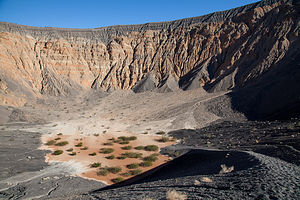 Ubehebe Crater with Tiny LoloOur last stop for the day was the Ubehebe Crater, a half-mile wide, 600-foot deep crater formed by volcanic explosions several thousand years ago. Although you can see the crater just fine from the parking lot, we decided that we needed to hike down to the bottom of it – why? because it was there. It was really steep, and we kind of slipped and slid along the loose cinders. After about 100 yards, Herb realized that sandals were probably not the shoe of choice and hiked back up to the car to change. Watching him take two steps forward and slide one back gave me a preview of just how tough the hike out was going to be. Oh well, we would worry about that when the time came. It really was pretty awesome standing on the flat floor of the crater looking up at its steep, multicolored walls. As with so many other places in this park, it was eerily silent. Quiet is good around a volcano. When it was time to leave, we selected a longer path that had a slightly shallower incline. Still, it was a pretty tough hike, made all the more difficult by the loose cinder surface.
Ubehebe Crater with Tiny LoloOur last stop for the day was the Ubehebe Crater, a half-mile wide, 600-foot deep crater formed by volcanic explosions several thousand years ago. Although you can see the crater just fine from the parking lot, we decided that we needed to hike down to the bottom of it – why? because it was there. It was really steep, and we kind of slipped and slid along the loose cinders. After about 100 yards, Herb realized that sandals were probably not the shoe of choice and hiked back up to the car to change. Watching him take two steps forward and slide one back gave me a preview of just how tough the hike out was going to be. Oh well, we would worry about that when the time came. It really was pretty awesome standing on the flat floor of the crater looking up at its steep, multicolored walls. As with so many other places in this park, it was eerily silent. Quiet is good around a volcano. When it was time to leave, we selected a longer path that had a slightly shallower incline. Still, it was a pretty tough hike, made all the more difficult by the loose cinder surface.
There are two other hiking options at Ubehebe – the 2-mile circuit around the rim and the 1-mile out-and-back to Little Hebe, a much smaller adjacent crater. It was getting late and we had already done what we felt was the hike of choice, so we got in the car and drove back south to Furnace Creek.
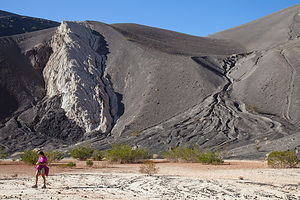 Lolo in Ubehebe CraterBack at the campground, I convinced Herb that he wanted to take me out on the town. Needless to say, our options were fairly limited, so we headed over to the 49er Café located at the Ranch at Furnace Creek. I liked the name and I thought it looked really cozy inside, and I didn’t have to cook in the RV, so spirits were high. Unfortunately, try as I might to like it, it really was a mediocre experience and pretty pricey for burgers and pasta. I guess they don’t have to worry too much about competition.
Lolo in Ubehebe CraterBack at the campground, I convinced Herb that he wanted to take me out on the town. Needless to say, our options were fairly limited, so we headed over to the 49er Café located at the Ranch at Furnace Creek. I liked the name and I thought it looked really cozy inside, and I didn’t have to cook in the RV, so spirits were high. Unfortunately, try as I might to like it, it really was a mediocre experience and pretty pricey for burgers and pasta. I guess they don’t have to worry too much about competition.
The night was still young – it gets dark so darn early and I was tired of going to bed at 9:00, so we went over to the Visitor Center to catch the evening program. I was desperate for entertainment. This evening’s show, believe it or not, was a musical performance by the University of Nevada at Las Vegas’ Marimba Band. If anyone had bet me that morning that I would be listening to Wagner's Tannhauser Overture played by a marimba band that evening, I would have said, “you’re on,” but that was exactly how we spent our last evening in Death Valley. It was as surreal as the landscape around us.
Description
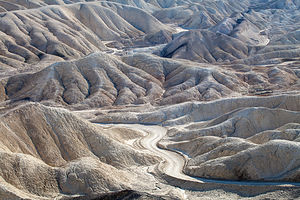 Twenty Mule Team Canyon RoadIn 1994, the Desert Protection Act added an additional 1.2 million acres to Death Valley National Monument and upgraded its status to National Park, making it the largest national park outside of Alaska. The park is located on the eastern border of a remote section of California with some small portions extending into Nevada. Despite its remoteness, it is one of the most highly visited parks in the national park systems. Many of these visitors come all the way from Europe and Japan to experience the extremes of this stunningly beautiful desert.
Twenty Mule Team Canyon RoadIn 1994, the Desert Protection Act added an additional 1.2 million acres to Death Valley National Monument and upgraded its status to National Park, making it the largest national park outside of Alaska. The park is located on the eastern border of a remote section of California with some small portions extending into Nevada. Despite its remoteness, it is one of the most highly visited parks in the national park systems. Many of these visitors come all the way from Europe and Japan to experience the extremes of this stunningly beautiful desert.
Death Valley received its name from the unfortunate forty-niners who were forced to cross the burning sands here in order to avoid the severe snowstorns in the nearby Sierra Nevada on their way to the California Gold Rush. Many perished along the way, and those that survived remembered it as a place of suffering and death. The current names of many of the places in Death Valley reflect its harshness: Dead Man Pass, Funeral Mountains, Furnace Creek, Hell’s Gate, Devil’s Golf Course, Starvation Canyon, etc.
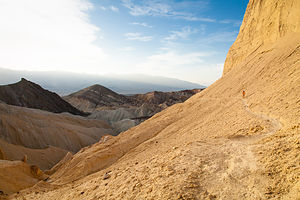 Golden Canyon TrailThe valley itself is over 130 miles long, but only about 12 miles wide, flanked on both sides by unvegetated reddish mountains. From an elevation of about 3,300 feet in the north, the land slopes steadily downward to an elevation of 279 feet below sea level at Badwater, the lowest point in the western hemisphere. In fact, 70 miles of the desert floor is below sea level, accounting for its extremely high termperatures, which can exceed 130°F in summer.
Golden Canyon TrailThe valley itself is over 130 miles long, but only about 12 miles wide, flanked on both sides by unvegetated reddish mountains. From an elevation of about 3,300 feet in the north, the land slopes steadily downward to an elevation of 279 feet below sea level at Badwater, the lowest point in the western hemisphere. In fact, 70 miles of the desert floor is below sea level, accounting for its extremely high termperatures, which can exceed 130°F in summer.
In many ways, not much about the valley has changed since the pioneers first crossed here. Its intense heat, frigid cold, and the driest air imaginable still make it one of the most inhospitable locations on earth. However, today’s visitors can enjoy Death Valley and see most of its highlights from the comfort of their air conditioned cars and stay in comfortable, and even luxurious, hotel rooms at night.
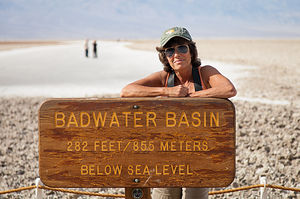 Lolo with Badwater Basin SignThe park is criss-crossed by a network of roads, ranging form washboard dirt ones to paved, well-maintained highways, making the most popular destinations quite accessible. The Furnace Creek Visitor Center, near the center of the park, is a great place to get oriented and to begin an exploration of Death Valley. This greenness of this area is a surprise to most visitors who come to the park expecting to see nothing but miles and miles of sand. Fed by warm springs, this area is a verdant oasis with palm trees as tall as 50 feet. There are also two world-class resorts here: the elegant Furnace Creek Inn and the more down-to-earth Furnace Creek Ranch.
Lolo with Badwater Basin SignThe park is criss-crossed by a network of roads, ranging form washboard dirt ones to paved, well-maintained highways, making the most popular destinations quite accessible. The Furnace Creek Visitor Center, near the center of the park, is a great place to get oriented and to begin an exploration of Death Valley. This greenness of this area is a surprise to most visitors who come to the park expecting to see nothing but miles and miles of sand. Fed by warm springs, this area is a verdant oasis with palm trees as tall as 50 feet. There are also two world-class resorts here: the elegant Furnace Creek Inn and the more down-to-earth Furnace Creek Ranch.
Highlights traveling south from Furnace Creek on Route 190
- About 5 miles south of the Furnace Creek Visitor Center is Zabriskie Point, one of the most spectacular overlooks in the park. A short walk uphill from the parking lot brings you to a panoramic view of Golden Canyon and the surrounding vibrantly colored badlands. The views are particularly stunning in the lowlight of early morning or late afternoon.
- Another 1.5 miles down the highway s the turnout for Twenty-Mule Team Canyon road, a one-way dirt road that rejoins the highway in 2.7 miles. The road winds through Twenty-Mule Team Canyon with close-up views of the same colorful badlands seen from Zabriskie Point. RVs and trailers are not allowed on this road.
- 4.5 miles further south on 190 is a turnoff for Dante’s View (restricted to vehicles less than 25 feet). The road to Dante’s View climbs steeply to an overlook 5,000 feet above the valley floor, where the temperatures average 20° F cooler than in the valley. From this viewpoint, which most consider the most breathtaking in the park, one can see the lowest point (Badwater) and the highest point (Telescope Peak) in the park.
Highlights traveling south from Furnace Creek on Badwater Road
- About 1.8 miles south of the Visitor Center is the turnoff for Badwater Road. 1.5 miles further south on Badwater Road is the parking lot for the popular hike into Golden Canyon. A well-marked nature trail (2 miles RT) leads into the narrow canyon, wedged in by eroded cliffs and the slopes of golden badlands.
- Back on Badwater Road, continue south past Artist Drive (get that on the way back as it is a one-way road going north). Around 9 miles south of Golden Canyon is the turnoff for the unpaved spur road to Devil’s Golf Course. The road leads to an odd and forbidding landscape created by salt and erosion on a lake bed that dried up 2,000 years ago. The result is a jagged terrain of salty white miniature mountains and spires, less than 2 feet high. The name comes from the feeling that “only the devil could play golf on such rough links.”
- About 8 miles south is the Badwater Basin, the hottest and lowest point in Death Valley accessible by car. Surprisingly, its permanent spring-fed pools also make it one of the wettest. Legend says that it got its name from a surveyor whose mule refused to drink it. Although not poisonous, it is similar in composition and taste to Epsom salts. Despite its apparent inhospitableness, it is home to water beetles, insect larvae, and a soft-shelled saltwater snail that slowly adapted to these conditions.
- Turning back north on Badwater Road towards Furnace Creek, in 8 miles you come to the turnout for the one-way, 9-mile paved Artist Drive, which winds through a colorful display of sedimentary and volcanic rock hidden from the main road. It received its name from the rainbow of colors—red, pink, yellow, orange, and brown—that paint these rocky hills. About half-way through the loop is the parking lot for Artists Palette, one of the most colorful areas along the loop. Artist Drive is restricted to vehicles less than 25 feet.
Highlights traveling north from Furnace Creek on Route 190
- About 1.7 miles north of the Furnace Creek Visitor Center are the remains of what was once the Harmony Borax Works. Borax, which the prospectors called “white gold,” was once a big business in Death Valley. In the 1880s, Chinese laborers were hired to rake borax “cottonballs” from the valley floor and bring them to the Harmony Borax works to be purified. From there the refined borax was loaded onto the famous twenty-mule team wagons and transported 165 miles across the desert to the train station in Mojave. From there it was shipped to processing plants where it was used to make soaps, disinfectants, and food preservatives. Between 1883 and 1927, more than $30 million worth of borax was produced in Death Valley. A short trail leads past the ruins of the old borax refinery and some outlying buildings. More information on the mining of borax in Death Valley is available in the Borax Museum at the Furnace Creek Ranch.
- 12 miles further north on 190 is the turnoff for the 1.2 mile gravel road to Salt Creek, home to the famous Death Valley pupfish. When the lake that once covered Death Valley dried up thousands of years ago, the desert pupfish was the only fish that managed to adapt to the harsh conditions here. Isolated from each other in scattered salty pools, springs, and creeks, nine types of pupfish have evolved. A tenth has already become extinct. They are found no place else on earth. The pupfish can often be seen from the short wooden boardwalk nature trail that crisscrosses the stream and marshes.
- About 21 miles north of the Visitor Center, Highway 190 turns west towards Stovepipe Wells and the west entrance to the park. At this point, you can either continue on 190 or head north on the North Highway another 32 miles to Scotty’s Castle, the major man-made attraction in Death Valley.
Highlights along the North Highway (traveling north)
- The drive to Scotty’s Castle on the North Highway is a very scenic one with desert stretching out on the west and mountains rising to the east. About 10 miles north on the North Highway is a pullout with great views of Death Valley’s renowned alluvial fans. These fans are something like an hourglass with debris from the mountains funneling through a narrow opening and spilling out in a wedge shape into the valley. They come in many shapes and sizes. The ones near this viewpoint are smaller and steeper.
- 25 miles further north in the remote Grapevine Canyon looms the unlikely sight of a Moorish Castle. Construction of what was more officially called Death Valley Ranch was begun in 1922 by Chicago millionaire Albert Johnson, whose doctors had advised him to spend more time in a warm, dry climate. However, the mansion is known as Scotty’s Castle, named after Johnson’s unlikely friend, Walter Scott. Walter Scott was a cowboy that had traveled with Buffalo Bill’s Wild West Show in the 1880s before taking up prospecting. Albert Johnson was one of Scotty’s gullible investors in his “secret gold mine” in Death Valley. After several trips west to see the mine, Johnson realized that he was being duped by Scotty. Despite that, Johnson truly enjoyed his new friend and the tall tales he told. Scotty helped Johnson conceive the idea of this vacation villa in Death Valley and lived in it after Johnson’s death.
- In 1970, Scotty’s Castle was purchased by the National Park Service from the foundation to whom Johnson had willed it. Today the colorful history of the castle is brought to life by rangers dressed in 1930s clothing that welcome you as if you were Scotty’s guests. The one-hour guided tour is excellent, both for its inside look at this unusual mansion as well as for the stories about the eccentricities of the two men that built it. Tours depart every 20 minutes from 9 am to 5 pm. Plan to arrive early because they fill up quickly.
- About 1.5 miles down Grapevine Canyon heading back south on the North Highway is the turnoff for the 8 mile road to Ubehebe Crater. This half-mile wide, 600-foot deep crater was formed by volcanic explosions several thousand years ago. Dark cinders and volcanic fragments cover the surrounding countryside. From the parking area there is a steep trail up to the crater’s rim. Be prepared to battle some very gusty winds.
- Because of its remote location, few visitors get to see the famous Death Valley Racetrack, where rocks mysteriously move across the dry lakebed on their own accord. Although no one has actually seen the rocks move, they are known to move because of the trails they leave behind them. After studying the phenomenon for decades, scientists now believe they have solved the mystery. The surface of the lakebed is a fine clay that becomes very slippery when wet. After a rain, heavy winds as high as 70 mph blow the rocks across the slick surface. A 4-wheel drive vehicle is needed to reach the Racetrack, which is 27 miles past Ubehebe Crater on a rough dirt road.
Highlights traveling west along Route 190 from the junction with the North Highway
- Just west of the junction is the parking area for the surrealistic Devil’s Cornfield. On both sides of the road are odd-looking clumps of brush four to ten feet tall that resemble corn stalks. They are actually arrowweed bushes, whose stems were used by Native Americans to make arrow shafts.
- A few miles further west on 190, pull over on the shoulder by a roadside display where the Sand Dunes come close to the highway. These are the highest of a 14-square-mile field of dunes. Although there are no trails to follow, hikers are free to roam the dunes on their own. The best time of day to visit the dunes is in the morning or late afternoon when the temperatures are cooler and the lighting is more dramatic.
- Two miles further west is the village of Stovepipe Wells, Death Valley’s first tourist resort. The village actually got its name from an historic site about 5 miles north where an old stovepipe was sunk into the sand to form the shaft of a well. For years this well was used by travelers as a source for water. Around 1926 a developer planned to build a small resort near the well. However, his lumber trucks got stuck in the sand before he could reach it. Rather than unload and reload his trucks, he decided to try and dig a well where they were. They struck water and stayed. That spot is the current location for Stovepipe Wells. Today the village has a motel, general store, saloon, restaurant, and campground.
Campgrounds that will accomodate RVs in Death Valley
- Furnace Creek Campground (136 sites, no hookups) – located just north of the Visitor Center. Open year round. This is the only park campground that takes reservations.
- Mesquite Spring Campground (30 sites, no hookups) – located 5 miles south of Scotty’s Castle. Open year round.
- Panamint Springs Resort (40 sites, 12 hookups) – located 30 miles west of Stovepipe Wells on Route 190. Open year round. This campground is privately operated and takes reservations.
- Stovepipe Wells Campground (200 sites, 15 hookups) – located in the village of Stovepipe Wells. Open year round.
- Sunset Campground (1000 sites, no hookups) – located .25 miles east of the Furnace Creek Ranch. Open October through April.
- Texas Spring Campground (92 sites, no hookups) – located near Sunset Campground. Open October through April.
- Wildrose Campground (30 sites, no hookups) – located 30 miles south of Stovepipe Wells off the Trona-Wildrose Road. Open year round.
In addition to the park campgrounds, there are two privately-owned campgrounds in the park:
- Furnace Creek Ranch Campground (26 sites, all full hookups) - located at The Ranch just south of the Visitor Center. Open year round. Guests can enjoy the Ranch’s natural spring-fed swimming pool, shower facility, coin operated laundry, tennis courts, shuffleboard, volleyball, Bocci Ball and basketball court.
- Panamint Springs Campground (37 sites, 12 full hookups) - located at the western end of Death Valley National Park on Highway 190 in the town of Panamint Springs
- ‹ previous
- 6 of 13
- next ›
Death Valley National Park location map in "high definition"
Javascript is required to view this map.
